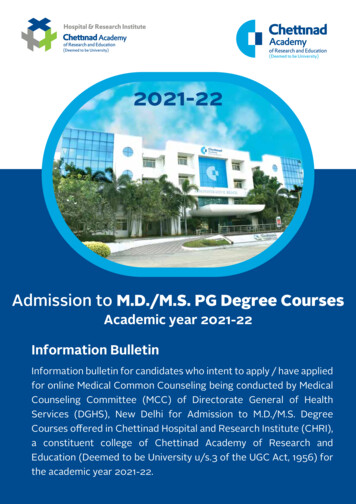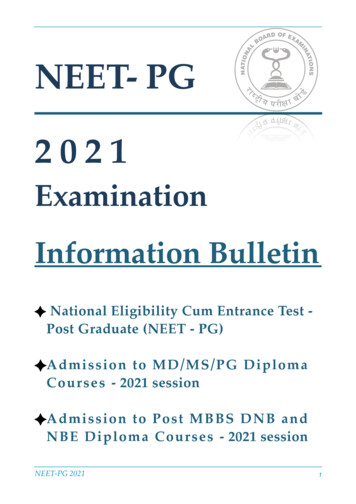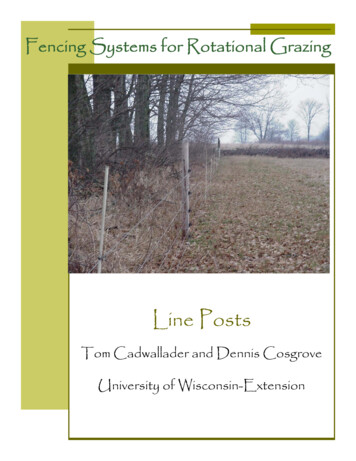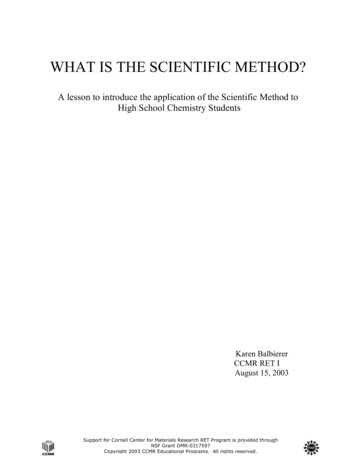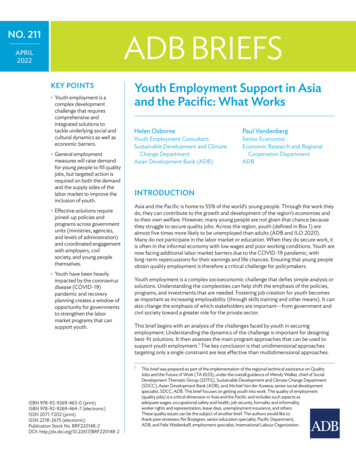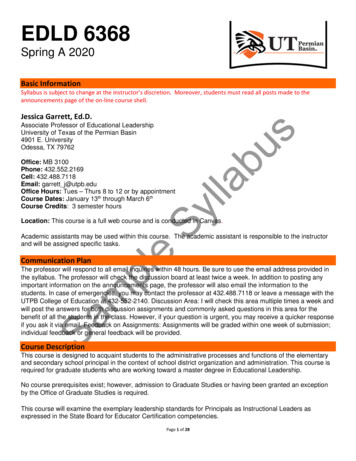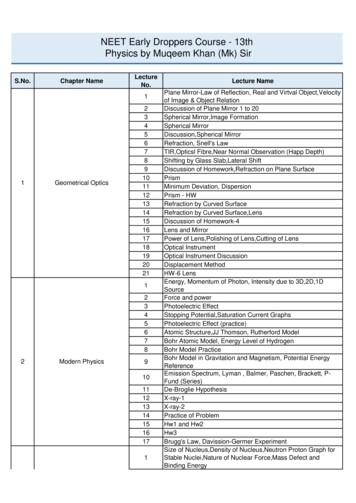
Transcription
NEET Early Droppers Course - 13thPhysics by Muqeem Khan (Mk) SirS.No.Chapter NameLectureNo.11Geometrical ern Physics910111213141516171Lecture NamePlane Mirror-Law of Reflection, Real and Virtval Object,Velocityof Image & Object RelationDiscussion of Plane Mirror 1 to 20Spherical Mirror,Image FormationSpherical MirrorDiscussion,Spherical MirrorRefraction, Snell's LawTIR,Opticsl Fibre,Near Normal Observation (Happ Depth)Shifting by Glass Slab,Lateral ShiftDiscussion of Homework,Refraction on Plane SurfacePrismMinimum Deviation, DispersionPrism - HWRefraction by Curved SurfaceRefraction by Curved Surface,LensDiscussion of Homework-4Lens and MirrorPower of Lens,Polishing of Lens,Cutting of LensOptical InstrumentOptical Instrument DiscussionDisplacement MethodHW-6 LensEnergy, Momentum of Photon, Intensity due to 3D,2D,1DSourceForce and powerPhotoelectric EffectStopping Potential,Saturation Current GraphsPhotoelectric Effect (practice)Atomic Structure,JJ Thomson, Rutherford ModelBohr Atomic Model, Energy Level of HydrogenBohr Model PracticeBohr Model in Gravitation and Magnetism, Potential EnergyReferenceEmission Spectrum, Lyman , Balmer, Paschen, Brackett, PFund (Series)De-Broglie HypothesisX-ray-1X-ray-2Practice of ProblemHw1 and Hw2Hw3Brugg's Law, Davission-Germer ExperimentSize of Nucleus,Density of Nucleus,Neutron Proton Graph forStable Nuclei,Nature of Nuclear Force,Mass Defect andBinding Energy
91011Q value in Terms of Wars Kg/ Amu, Q Value in Terms ofBinding Energy and Kinetic Energy,Binding Energy and Massno Graph, Fusion and Nuclear Fusion, α-decayFission Reaction u235 ,Chain Reaction,NatualUranium,Neutron Reproduction Factor,NuclearReaction,Nuclear FusionDecay of Alpha ,Beta ,Gamma ParticlesRadio ActivityDicussion of Homework -1,2(Q.1 to 10)Discussion of Homework -2(10 to 25),3 and Production ofNuclear Substances,Parallel Decay,Successive Decay,RockAnalysis,K CaptureMotion in One Dimension,Constant Accelerated MotionGraphsDiscussion of Homework -1Concept of Basic Differentiation,Discussion of Homework -2DiscussionBasic Integration,Projectile MotionProjectile Motion Examples,Maximum Height and Time ofFlight Variation with QProjectile Analysis Example,Incline Projectile,Discussion ofHomework -3Projectile From Height,Relative Motion,Min. Distance(Closest Approach),Rain Man ProblemDiscussion of Homework-4 and River ProblemFlag Fluttering and Homework-5 and River Boat ProblemDiscussion of Homework -61Newton's First Law,2nd Law,3rd Law,FBD,Atwood Machine23Nuclear Physics34567123454Kinematics678235Newton s Law of Motion(NLM)and Friction45671267Circular MotionWork, Power and EnergyExample Based on Newton's 2nd Law,String Block System(Constrained)String Constraint,Heavy String,Spring,SpringBalance,Weighing Machine,Homework-1Pseudo Force and Discussion of Homework -2,3Friction-Basic Concepts,Static and Kinetic Friction,illustrationBased on FrictionMinimum Force required to Slides a System,Problem Based onInclined,Discussion ofHomework -4Angle of Repose,2 Block System,Discussion of Homework-5Relation Between Linear Velocity and Angular velocity,UniformCircular MotionAnalysis Between Linear and Circular Motion,Relative AngularVelocity,Tangential Acceleration and CentripetalAcceleration,Angular Acceleration3Uniform and Non uniform Circular,Radius of Curvature,SimplePendulum and Conical Pendulum,Banked Road4Discussion of Exercise -1,21Work Done by Constant Force,Work Done in Cartesian System2Potential Energy,Kinetic Energy,Work EnergyTheorem,Conservation of Mechanical Energy
756Conservative and Non-Conservative Force,CentralForce,Problem Based on Energy Conservation,UNR Graph,Discussion of Homework-1Power and Discussion of Homework -2Vertical Circular Motion and Discussion of Homework -3Calculation of COMCalculation of COM,Discission of Homework -1(Calculation ofCOM)Motion of COM,Man & Planck''''s Problem,GumProblems,Discussion of Homework -2(Motion of COM)Impulsive Force,Collision (Head on Collision),Special Case onHead on CollisionBouncing of Ball ,Oblique Collision,Discussion of Homework 3,4Rigid Body,Rotational Kinematics,Analogy Between Translationand Rotation,TorqueMoment of Inertia,Cavity ProblemMomentum of Inertia and Radius of Gyration,CompositePulley,Discussion of Homework -1Angular Momentum Conservation of Angular MomentumDiscussion Homework 02Toppling ,CTRM,RollingRolling on Qnclined Angular Momentum CTRM1Properties of Charge,Coulamb's Law,Equilibrium Problems2Electric Field Due to Point Charge,Line ,Ring and Discussion ofHomework -13Electric Field Lines,Electric Flux,Gauss's Theorem,Discussionof Homework -02, Electric Field and FluxWork, Power and Energy345128Center of Mass and collision345129Rotational Motion34410Electrostatics5678341Current,Current Density, Power Generated Per Unit Volume2Resistance, Kirchhoff’s 1st Law, Kirchhoff’s 2nd LawImportant Point in Current Electricity ,Discussion of Homework 1Gravitation2312Current ElectricityMotion of Charge Particle in Uniform Electric Field,SelfEnergy,Self Practice Problem and Discussion of Homework -5"Newton''''s Law of Gravitation,Vector Form of GravitationLaw,Binary Star System ,Gravitation Field,Effect of g Due toEffect of Shape,Effect of g Due to Effect of Rotation,Variationof g in Radial Direction"Potential Energy ,Gravitational Potential,Discussion ofHomework-01Escape Velocity, Binding Energy, SatelliteKepler’s Law, Satellite, Discussion-03111Application of Gauss;s law Relation Between E and V,ProblemBased on Flux,Potential EnergyElectrostatic Potential, Equipotential Surface, Conductor,Discussion H.W.- 03Conductor,Discussion-H.w-04 (conductor)"Dipole,Electric Field Due to Dipole in Axial line & EquitorialLine, Potential Due to Dipole, Torque on Dipole in uniform E,PE of Dipole in Uniform Electric Field"
56Circuit Theory (Nodal Analysis), Battery, Combination ofResistanceGalvanometer, Voltmeter, AmmeterCombination of Battery, Discussion of Homework-027Heating Effect, Maximum Power Transfer, Combination of Bulb8910111213Discussion H.W -3Meter BridgePotentiometerDiscussion of Homework-04R-C CircuitRC Circuit, Discussion of Homework-05Spherical Capacitor, Parallel Plate Capacitor, Energy Stored inParallel Plate CapacitorForce Between Parallel Plates of Capacitor,Work Done byBattery,Dielectric Medium, Energy Density412Current Electricity1213Capacitor3Insertion of Dielectric, Practical Capacitor, Breakdown Voltage41Combination of Capacitor,Discussion of Homework-01Charge Distribution, Cylindrical Capacitor, Discussion ofHomework-02Introduction ,Biot Savart Law2Practice Problems on Magnetic Field ,Arc ,Straight Line ,Spiral5345614Magnetic Effect of Current7891011121215Electro-Magnetic Induction (EMI)3456116Alternating Current (AC)Graph,Magnetic Field Due to Polygon,Magnetic Field Due toMoving Charge and Discussion of Homework 1 to 25Ampere''''s law and Its Applications on (Long Wire,ThickWire,Thin Pipe,Thin Sheet,Solenoid)Ampere''''s Law Application Practice, Discussion of Homework02Force on Moving Charge in Magnetic Field, Circular Path,Helical PathCyclotron, Force on Charged Particle When Electric Field AndMagnetic Field Both Are Available,Discussion of Homework-03Force on Current Carrying Wire, Torque on Current CarryingLoop, Magnetic Moment of LoopMagnetism Moment, Torque Due to Magnetic Field, PotentialEnergy, Moving Coil GalvanometerEarth Magnetism, Discussion of Homework-04Tangent Galvanometer, Vibrational Magnetometer, Discussionof Homework-05Magnetic Propetion Dia, Para, Ferro Magnetism Hysterisis.Discussion-6Motional EMF, Gauss Law, Faradays LawMotional EMF,Faraday’s Law, Lenz’s Law"EMF in Direction of Induced Current, Graph Between Flux vsTime and EMF vs Time, Discussion of Homework- 01"Induced Electric Field, InductorL.R Circuit, A.C Motor, D.C MotorMutual Inductance, Discussion of Homework-02(Q1-30)RMS, Mean square Value, Average Value, Phasor Analysis,Pure Resistive Circuit, Pure Inductive, Pure Capacitive Circuit,Mix Circuit
16Alternating Current (AC)6"Series Circuit, Parallel Circuit, Power in A.C, Power Factor,Wattless Current (Homework-1)"L.C Oscillations, Resonance, Transformer, Homework-2Home Work -3Pressure, Variation of Pressure in Accelerated Container,Force on Wall, Mercury Barometer, Open Tube ManometerHydraulic Lift(Pascal’s Law)Archimede''''s PrincipleContinuity Equation, Bernoulli''''s Equation , Discussion Hw-1"Velocity of Efflux, Force Due to Water Jet, Rotating Fluid,Discussion of Homework-02 and 03""Surface Tension- (1)Cohesive Adhesive (2)Contact Angle(3)Surface Energy (4)Atomization (5)Excess Pressure insideCurved Surface"Capillary-Cylindrical-Conical, Viscosity7Viscosity Stokes Law Reynolds Number Poiseuille''''s Equation23412317Fluid Mechanics451218Simple Harmonic Motion (SHM)3451Types of Waves, Equation of Wave, Graphical Representation2"Velocity, Acceleration & Displacement of Particle Wave,Quantitative Relation Between Velocity,Acceleration &Displacement "3Velocity of Waves in String, Velocity of Waves in Heavy String419Waves( String wave & Sound Wave )5678910111220Wave OpticsOscillation Vibration Periodic Motion Differential Equation OfSHM UCM To SHM Phase Equation OF SHM Relation BetwinV& X And A And X"Mean Position Shifted From Origin, Time Period of Spring Mass System, SHM with Spring String and 2-SHM with""Graphs, Spring-mass, Combination of Spring, SpecialProblem, Discussion of Homework-01""Energy - KE, PE, TE, Spring with Two Blocks LongPendulum,Tunnel in Earth SHM"Damped Harmonic Oscillation, Forced Harmonic Oscillation,H.W.-334"Energy, KE,PE, Energy Density, Power, Intensity, Discussionof Homework-01"Power, Interference, Reflection & Transmission, Equation ofReflected wave and Transmitted WaveStanding Wave"Sound Waves as Pressure Waves, Velocity of Sound Wave,Intensity in Terms of Pressure, Standing Wave-Organ Pipes"Resonance Column Experimental Beats, Discussion ofhomework-02Quincke’s Tube, Sonometer,Kundt’s Tube, Doppler Effect,EchoDiscussion of Homework- 03 & 04Discussion of Homework- 05Newton''''s Corpuscular Theory, Huygen''''s Theory , YDSEExperimentAngular Fungi Width Unequal Slit Width Optical Path LenghtStab Poroblem YDSE in Medium Non Coherent SourcesYDSE- Oblique Incidence, Fresnel Biprism, Lloyd’s Mirror, ThinFilm InterferenceDiscussion of Homework-01 And 02, Diffraction, Polarization
20Wave Optics56121Semiconductor2341222Elasticity,Thermal expansion&Calorimetry34523Heat Transfer671234124Kinetic Theory of Gases&Thermodynamics23425Measurement and Error1226Vector12Complete Revision Polarization by Reflection and ScatteringH.W-3"Basic Ideas, Gauss’s Law, Modified Ampere’s Law,Displacement Current, Energy Density, Intensity""Energy Band ,Doping ,P-N Diode -Forward Biasing / ReverseBiasing Zener Breakdown,Avalanche Breakdown"Rectifier-Half Wave/Full Wave/Bridge,Resistivity andConductivity,Photodiode,LED,Solar CellTransistorLogic Gate, Discussion of Homework-01"Deforming Force, Longitudinal(Stress/Strain), Young Modulusof Elasticity, Elastic Potential Energy, Heavy Rod"Modulus of Rigidity, Bulk Modulus, Stress-Strain surneElastic Hysterisis, Poission Ration, Effect of Temp, & impurity,Discussion of homeworkTemperature, Heat, α(Alpha), β(Beta), g(Gamma)"Relation Between α(Alpha), β(Beta), g(Gamma), Metal Scale,Bi-Metallic Strip, Pendulum Clock, Thermal Stress"Discussion of Homework of Thermal ExpansionCalorimeteryConduction/Convection , Discussion of Homework-01Radiation : Stefen-Boltzmann LawRadiation -HW dIscussionNewton’s Law of Cooling, Wien’s Displacement Law, SolarConstantKinetic theory of gas , vrms, vav, v most probableMean Free Path Relaxation Time 1st Law of Thermodynamics2nd Law of ThermodynamicsProcess2nd Law of Thermodynamics, Carnot Cycle, Refrigerator,Discussion of Homework-2Unit & Dimensions Application of Dimensions SignificantFigures ErrorsVernier Caliper Screw Gauge H.W of Unit Dimension ErrorRepresentation of Vector Types of vector Angle b/w VectorsAddition of Vector Resolution of Vector in rectangularComponents 2-d resolution of Vector in 3-DDot Product Cross Product Discussion
NEET Early Droppers Course - 13thPhysical & Inorganic Chemistry by Jitendra Hirwani (JH) Sir &Prince Singh (PS) SirS.No. Chapter NameLectureNo.6Basic Moles and its Calculation,Calculation of Number ofAtoms,Molecules,Ions, Electrons,Protons and Neutrons,Calculation of Charge,Practice Session -1Average Atomic Mass of Isotopic Mixtures,Average Molar Massof Gaseous Mixtures Percentage Composition,Laws ofChemicalCombination,Practice Session -2Emperical and Molecular Formula Stoichiometry andStoichiometric Calculations, Practice Session -3Limiting Reagent,Percent Yield and Percent Purity,PracticeSession -4Mixture Analysis,Principle of Atom Conservation (POAC)Series or Sequential ReactionsConcentration Terms and their Interconversion7Application of Molarity,Molarity of Dilution,Molarity of Mixing1231Mole Concept (PS Sir)4581232Periodic Table (PS Sir)453Lecture NameLabelling of H2O2, Methodes of Atomic & Molecular MassDeterminationIntroduction,Periodic Table and BasicsShielding Effect and Effective Nuclear ChargeIonisation Energy, Factors Affecting Ionisation of I.E, PracticeSessionElectron Gain Enthalpy and Electron Affinity,Variation andIrregularities in Electron Affinities,Acidic Basic and Amphoteric Oxides,Hydration Energy and itsApplication,Practice Session-31"Rate of Reaction,Rate of Appearance andDisappearance,Rate of Reaction in Terms of Pressure, RateLaw,Elementary andComplex Reactions,Order and Molecularity,Practice Session-1"2"Chemical Kinetics, Significance of Order of Reaction, Unit ofRate Constant,Analysis of Zero Order Reaction"3"Kinetics of First Order Reaction and their Characteristics,Second Order Reaction and Characteristics"Chemical Kinetics (PS Sir)45"Determination of First Order Rate Constant Role ofStoichiometric Coefficients,Practice Session "Pseudo First Order Reaction,Collision Theory,ArrheniusEquation and its Application1"Introduction,Types of Chemical Bond,Discussion of IonicBond, Covalent Bond and Coordinate Bond,Lewis Octet Rule"2"Exception of LOR,Failure of LOR,Formal Charge,Structure ofCompounds having Single Central Atom, Valence Bond Theory(VBT)
3454Chemical Bonding (JH Sir)678910111213141515Chemical Equilibrium(PS Sir)234126Ionic Equilibrium (PS Sir)34567"Valence Bond Theory Continued - P-P,P-d,d-dOverlap,Comparison of Strength of σ and π Bond, Differenceof σ and π Bond,Formation of Molecules on the Basic ofValence Bond Theory"Hybridisation and Valence Shell Electron Pair RepulsionTheory"Hybridisation in Reaction ) , Hybridization inAllene,Hybridisation in odd Electron Species, Dimerisation ofodd Electron Species,Drago''''s Rule,Calculation of pπ-pπ andpπ-dπ Bond"Bent''''s Rule and its ApplicationMolecular Orbital Theory (MOT)MOT (continued),Back Bonding and Bridge Bonding"Bonding Parameters-Bond Angle,Bond Order, Bond Length(All Important Questions are Covered)"Bond Energy, Dipole Momentintermolecular forces ( vandwrwall forces) Hydrogenbonding{formation, extent, strength, number, types (symmetrical and unsymmetrical, intermolecular andintramolecular, application}Covalent Character in Ionic Compound, Fajan''''s Rule and itsApplicationDiscussion of Practice Session -1Discussion of Practice Session -2Discussion of Practice Session -3Characteristics of Chemical Equilibrium,Equilibrium Constantand its types Relation between Kp and Kc, Characteristics ofEquilibriumConstant,Practice Session-1Calculation of Equilibrium Constant in Different CasesSignificance of value of Equilibrium Constant, ReactionQuotient and Le chatelier’s PrincipleEffect of Temperature Change,Effect of inert gas Addition,Effect of Catalyst,Phase Equilibrium and Triple phase Diagram"Arrhenius Theory, Bronsted Lowry Concept,AmphiproticSpecies,Conjugate Acid Base Pairs, Levelling Effect,Arrhenius Theory ofElectrolytic Dissociation, Ostwald''''s Dilution Law,PracticeSession-1""Common Ion Effect,Properties of Water,Ionic Product ofWater, pH Scale. pH Calculation for Strong Acids andBases,Mixture ofAcids and Bases,pH due to weak Acid or Base""pH for Weak Acid and Weak Base,pH of Mixture of StrongAcid and Weak Acid, ph of Mixture of Two WeakAcids,Practice Session 2"Salt HydrolysisSalt Hydrolysis,Buffer SolutionsAcid Base Titration Theory of Indicators,Solubility and Solubility Product,Solubilityin Different Cases
127Coordination Compound (PS Sir)345612348Thermodynamics (JH Sir)5678910129Thermochemistry (JH Sir)34110Metallurgy (PS Sir)2345611Electrochemistry (PS Sir)Introduction,Basic Terms used,Classification of Ligands ,Classical and non-classical Ligands,Effective Atomic NumberNomenclature of Coordination Compounds,WernersCoordination Theory"Valence Bond Theory,Crystal Field Theory,Splitting inOctahedral, Tetrahedral and Square Planar Field,Filling ofElectrons and CFSE"Practice Session-4, Stability and Colors of Complexes"Bonding in Metal Carbonyls and Organometallics, Structuraland Geometrical Isomerism"Optical Isomerism, Uses of Coordination compound, PracticeSession-6Introduction and all Basic TheoryHeat, Workinternal energy, enthalpy,FLOAT , calculation of H, U , q & wfor (i) phase change(ii) chemical reaction (iii) change of state ofideal gas- isothermal processIsothermal, Adiabatic, Isobaric and Isochoric Process"Discussion of Practise Session-1, Polytropic Process, FreeExpansion, Comparison of Isothermal and Adiabatic Process"SLOT, EntropyCalculation of EntropyThird Law of Thermodynamics , COMPARISON OFENTROPY, Gibbs energydiscussion of practise session 2, calculation of Gpractise session 3, G and equilibrium constant, physicalsignificance of GIntroduction,Hess''''s Law,Lavoisier and Laplace Law Enthalpyof Reaction Thermochemical Equation ,Enthalpy of FormationHeat of Formation, Heat of Combustion, Application, PracticeSession -1Enthalpy of Neutralisation,Ionisation,Sublimation ,FusionVaporization Hydration Solutions,Lattice Enthalpy BondEnthalpy ,Born-Tiabes CycleEnthalpy of Atomisation, Practice Session-2, Practice Session3Metallurgy, types of ores, methods of concentration - gravityseparation, magnetic separation, froth flotation methodChemical Method (Leaching), RoastingReduction of Oxide to Metal and Refining of MetalsThermodynamics of Metallurgy, ellingham Diagram, Extractionof FeExtraction of Cu, Extraction of AlExtraction of Ag and Au1Electrochemical cells and their types, Construction of galvaniccell, Electrode potential values and their significance2EMF of Cell, Standard Hydrogen Electrode, Gibbs free energyand EMF of cell, NERNST Equation and its application
11Electrochemistry (PS Sir)34512s-Block (JH Sir)6123412313Liquid Solution (JH Sir)4561234514p-Block (JH Sir)6789101112131415115Solid State (PS Sir)2312316Gaseous State (JH Sir)Concentration Cells, Different type of Half cells, Combining twohalf cells , Thermodynamics of galvanic cellElectrolysis and electrolytic cell , Qualitative Electrolysis,Quantitative electrolysis(Faraday''''s Laws)"Conductance and Conductivity Cell, Molar and Equivalentconductivity, Variation of molar conductivity with dilutionKohlrausch's law& Its application "Primary and Secondary BatteriesDiscussion of physical and chemical propertiesCompounds of alkali metalCompounds of Alkaline Aarth MetalDiscussion of Practise Session-1Concentration Terms, Vapour Pressure of Pure LiquidColligative PropertiesPRACTISE SESSION 1, OSMOTIC PRESSURE , ABNORMALCOLLIGATICE PROPERTIESVapour Pressure of a solution containing 2 volatile liquidspractice session-2, concept of fractional distillation, ideal andnon ideal solution, azeotropePractice Session-3 , Henry''''s Law"Boron Family ( Physical and Chemical Properties, Extractionof Boron, Diborane)"Boron Family ( Borax, Boric Acid, Alumina, AlCl3, Alums)Carbon Family( Physical and Chemical Properties, Allotropesof Carbon { Diamond, Graphite Fullerene}, CO, CO2, C3O2Silicates and SiloconNitrogen Family ( Physical and Chemical Properties, Nitrogen,Ammonia)Ammonia (NH3), Nitric Acid (HNO3), Nitrous Acid (HNO2)Phosphorus and its CompoundsOxygen Family Part -1Oxygen Family Part -2Halogen Family Part -1Halogen Family Part -2Noble GasesDiscussion of Practice Session -1Discussion of Practice Session -2Discussion of Practice Session -3Crystalline and amorphous solids , types of crystalline solids,Bravais Lattices, Analysis of unit cells"Practice Session-1, Close Packing of Atoms, HCP Unit Cell,Tetrahedral and Octahedral Voids""Radius Ratio and Lattices of Ionic Solids, Defects in Crystalsand Magnetic Properties"Gaseous State Part -1Gaseous State Part -2Gaseous State Part -3
16Gaseous State (JH Sir)456117d-Block & f-Block Elements(PS Sir)234118Atomic Structure (PS Sir)23419Surface Chemistry (JH Sir)20Hydrogen & its Compounds (JHSir)12345123451221Redox Reaction (JH Sir)345"VGE, Explanation of Z from VGE, Boyle''''s Temperature,Liquefaction of Gases, Critical Pressure, Critical Temperature,Critical Volume"Practice Session -1Practice Session -2"Introduction, Electronic Configuration, Melting and BoilingPoint of Transition Elements, Oxidation States and Colour"Catalytic properties, Trends in electrode potential values ,Alloy formation , interstitial compound , preparation andproperties of K2Cr2O7KMnO4 and its properties, Important compounds of Iron andtheir propertiesElectronic Configuration and Oxidation States, Properties ofLanthanides & ActinidesCathode and Anode Rays, Rutherford''''s Atomic Model, PlanckQuantum Theory, Photo Electric EffectBohr''''s Model, Formula Related to Bohr''''s Model, HydrogenSpectrumDiscuss Practice Session 2 and 3Rules for Writing Electronic Configuration, Schrodinger''''sWave EquationAbsorbtionCatalysisCollides Part-1Collides Part-2Discussion of Practice Session -1Hydrogen Compounds Part-1Hydrogen Compounds Part-2Hydrogen Compounds Part-3Discussion of Practice Session -1Discussion of Practice Session -2Oxidation Number, Oxidation Reduction, Oxidising Agent andReducing AgentPractice Session-1, Types of Redox Reactions, (i)interMolecular (ii) intraMolecularBalancing of Redox Reaction, Concept of Equivalent Weight,Equivalent Weight of AcidEquivalent of Base, Salt,ion, Element, Oxiding Agent andReducing Agent, Normality/No. of Equivalent , Law ofEquivalencePractice Session-2,3, Titration (Acid Base, Redox)
NEET Early Droppers Course - 13thOrganic Chemistry by Dr. Sanjay Yadav (SY) SirS.No. Chapter NameLectureNo.134567Inductive effect and its types,Application of I-effectResonance coordination of resonance method of resonance,Method of resonance, R and -R groupSyability of resonating structures, AromaticityResonance energyHyperconjugationApplication of all effectApplication of all effect8Audity of diff acids, phenol & benzoic acid and derivatives21General OrganicChemistry(10)9121(a) Geometrical Isomerism-Difference between structural &stereoisomerisms, Introduction of geometrical isomerism(8)Audity of diff acids, phenol & benzoic acid and derivativesBasic strengthBasic strengthIntroduction, method of presentation of O.C. (bondLinenotation)Classification/ types of C, H, R-X, R-OH, Amines, FunctionalgroupHomologous series Degree of unsaturationIUPAC-Naming RuleIUPAC-Naming RuleIUPAC-Naming ExamplesIUPAC-Naming ExamplesIUPAC-Naming Examples, IUPAC-Naming AromaticCompound, MiscellaneousStructural Isomerism (Inducting tautomerism)Structural Isomerism (Inducting tautomerism)10Classification andNomenclature ofOrganic Compound(7)Lecture Name56Condition of geometrical isomerismNaming of G.I,. (cis trans, E-Z, syn-anti)Properties of G.I. isomers, calculation of G.Is.(b) Conformational Analysis-Basic ideas information forconformational analysisConformations in acylic compoundsConformations in acydic cyclic compoundsConformations in acydic compounds(c) Optical Isomerism-Introduction, variation of q, chiral atomElements of symmetry (plane, centre)Elements of symmetry (AAOS, AOS), Condition for OpticalactivityMethods of representation of diff. molecule and theirinterconversion
7812Configuration of compound (D/L - and R/S)Optical isomerism in compound with one and two chiralcentreMeso compound, Enantiomers, Diastereomers, RacemicmixtureResolution, optical purity, Enantiomeric excess, Calculation,stereoisomersReactant reagents-Electrophile, nucleophile, Variation ofElectrophilicity and nucleophilicityCarbocation-General ,General reaction and itsrearrangementsImportant Reaction involving carbocation (R-X, form Rxn)5HalogenDerivatives(17)3Addition of HX and H3O addition with alkenes / alkynes456Addition of X2, IX, NOX, HO-X with alkenes/alkynes7Pinacol-Pinacolone rearrangement, Demjanavrearrangement, Dienone Phenol8Nucleophillic Substitution reaction (SN-RXN)-SN1 & SN2910Comparision of SN1 & SN2Examples of SN reactions of R-X, R-OH, R-O-R11Examples of SN reactions of R-X, R-OH, R-O-R SNGNP1213141516171236Alcohol & Ether(6)OMDM, HBODehydration of alcohol (E1-Reaction)Elimination Reaction-E1, E2, E1CBE1, E2, E1CBOrientation of E.R.Pyrrolytic / thermal ellimination rxnDehydration, DehalogenationImportant Reaction involving FR (Kolbe, Electrolysis, wurtzreaction) and related reactionsPhotohalogenation (Chlorination, Bromination)Per-oxide effect, NBS Rxn, Pinacol-form nGrignard Reagent- Grignard Reagent - 1Grignard Reagent - 2Reduction of various functional group-Reduction by H2/catReduction by LiAlH44561Reduction by SBH, BH3-THF/H , DIBAL-HSome important reductionOxidation- Oxidation - 1 (Alkane, alkene, alkyne)Oxidation - 2 (Alkane, alkene, alkyne)Oxidation - 3 (R-OH, R-X)Oxidation - 4 (Aldehyde)Heating effect- Heating effect on various compound - (2)Heating effect on various compound - (2)7Carbonyl compounds(Aldehyde, Ketone)
7Carbonyl compounds(Aldehyde, Ketone)(5)23458Carboxylic AcidDerivatives andAmines(4)123419Aromatic Compound(4)234110Biomolecules(5)2345Nucleophilic addition reaction -Reaction with NaHSO3, HCN,H2O, H2N-ZReaction with R-OHName reactions- Haloform reactionAldol condensation reactionCannizaro's reacionSome other reactionsCarboxylic acid derivatives-G.M.P. (General Method ofPreparation)G.M.P. (General Method of Preparation and Reactions)General reactionsGeneral Method of PreparationReactions of AminesReactions of AminesBenzene diazonium chloride and its rxnAlkanesAlkenesAlkynesBenzenePhenols- G.M.P.Rxn. of PhenolRxn. of PhenolAniline-G.M.P. & GR, Test of phenol and aniline, couplingreactionsChlorobenzeneAmino Acid & Proteins-Introduction, classification, physicalproperties isoelectronic pointReaction of Amino acid, protein and its classificationCarbohydrates-Introduction, ClassificationStructure of monoseccharides (Glucose, fructose)Reactions of monoseccharidesDisaccharides and polysaccharidesPolymersChemistry in every day life
NEET Early Droppers Course - 13thBiology by Dr. Akanksha Agarwal (AA)(MS) SirS.No. Chapter NameLectureNo.11Reproduction in Organisms2312342Human Reproduction567813Reproductive Health2124Sexual Reproduction inFlowering Plants34Lecture NameIntroduction,Life Span & Life Expectancy,Difference BetweenAsexual & SexualReproduction,Fission,Budding,Frag D3:D22mentation,Regeneration,SporulationVegetative Propagation – Natural and ArtificialSexual Reproduction in Organisms PreFertilization,Fertilization and Post-Fertilization eventsParthenogenesisSteps of Reproduction, Male Reproductive SystemTestes,Epididymis,Vasa Deferens,Glands,PenisSeminiferous Tubules,Sertoli Cells,Leydig Cells,HormonalControl,Spermatogenesis,Structure of Human Sperm,Disorders of Male Reproductive SystemFemale Reproduction System-Ovary,FT,Uterus,CervixVagina,External Genitalia,Bartholin,Skene and MammaryGlandsFollicle Development in Ovary,OogenesisFraternal Twins,Hormonal Control in Females,Menstrual Cycle,Estrous and Rut Cycle,Egg Membranes,Types of EggsStructure of Human Egg Fertilization Post Fertilization EventsCleevage,Morula,Blastocyst Types of Cleevage MonozygoticTwinsImplantation Extra-Embryonic Membranes GastrulationNeurulation Fate of Three Germ Layers Placenta – Introduction& TypesHuman Placenta Teratogens Umbilical Cord Gestation PeriodParturition Lactation Menstrual HygieneIntroduction-2011 Census Overpopulation and Its SolutionAmniocentesis MTP InfertilityContraception – Temporary & Permanent Sexually transmittedInfectionsStructure of Flower Androecium Structure ofStamen,Anther,Anther Wall Structure of MicrosporangiaMicrosporogenesis Pollen GrainDevelopment of Male GametophyteGynoecium,Megasporangium (Ovule) Structure & Its TypesMegasporogenesis Development of Female GametophytePollination and It''''s Types, Adaptations for Self and CrossPollination,Hydrophily Epihydrophily Agents ofPollination,Mutualism,Pollen-Pistil Interaction,DoubleFertilizationPost-Fertilisation Events Embryo Development in Dicots &Monocots Endosperm Development and Types Seed Structurein Dicots and Monocots Endospermic and Non-EndospermicSeeds
5125Evolution3Human Health and Disease45Evolution of Horse Human Evolution1Classification of Human Disease Germ Theory of DiseaseKoch’s Postulates Bacterial ,Pneumonia,Scarlet y2Viral Diseases (Small mps,Polio,Hepatitis) ProtozoalDisease (Giardiasis,Trypanosomiasis,Leishmaniasis )456717Microbes in Human WelfareOrigin of Universe and Earth Theories of Origin of Life on EarthTheory of Abiogenesis,Biogenesis and Chemical EvolutionExperimental Proof of Chemical Evolution - Spark DischargeExperiment ProtobiontsEvidences for Evolution Morphological and Anatomical –Homologous,Analogous ,Vestigeal,Atavism,Connecting LinksBiochemical,Embryological,Biogeographical EvidencePaleontological Evidence,Carbon Dating,Geological TimeScaleGeological Time Scale Theories for Biological EvolutionLamarckism Weismann Theory of Cont
8 Shifting by Glass Slab,Lateral Shift 9 Discussion of Homework,Refraction on Plane Surface 10 Prism 11 Minimum Deviation, Dispersion 12 Prism - HW 13 Refraction by Curved Surface 14 Refraction by Curved Surface,Lens 15 Discussion of Homework-4 16 Lens and Mirror 17 Power of Lens,Polishing of Lens,Cutting of Lens 18 Optical Instrument

